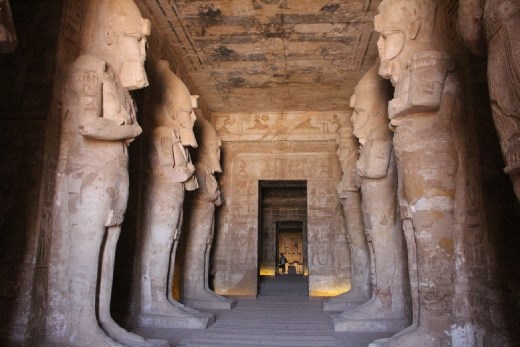No matter how many lessons on Ancient Egypt you had in history class or how many times you've seen hieroglyphics in National Geographic or on the History Channel, nothing will prepare you for seeing them in person. The temples of Abu Simbel are an architectural masterpiece in every sense of the word. Some people pay a few hundred dollars for a day trip from Aswan but I got a minibus this morning for only about $5 (US). Foreigners are technically not allowed on minibuses but as with many places, rules can be bent. As we passed through a police checkpoint, the driver had someone close the curtain next to me so I couldn't be seen. Getting dropped in Abu Simbel Village, I had my first hitchhiking experience in Egypt as two guys would drop me at the entrance to the temple. Since it's low season and with Egypt being desperate to lure back tourists, many sites are offering the student rate. Instead of 290 Egyptian pounds, I paid only 145: a small price for such a magnificent set of temples. Built in approximately 1264 BC by Ramesses II, the temples are carved out of solid rock. With a reign of 66 years, Ramesses II was the longest reigning pharaoh of Ancient Egypt. He built many temples in the area but none more masterful than Abul Simbel. By 6th century BC the temples were forgotten, covered by the sands of the Sahara, and weren't rediscovered until the early 19th century.
The Great Temple, on the left, is dedicated to the gods Amun, Ptah, and Ra. The Small Temple, on the right, is dedicated to Hathor and Nefertari.

Four statues of Ramesses II are in front of the Great Temple, though the second statue collapsed centuries ago. First I went into the Small Temple. The interior of the temples is what brings out even more their history and beauty. Hieroglyphics and carvings dominate the walls from the floor to the ceiling no matter where you go.



The interior of the Small Temple isn't that large. The interior of the Great Temple is even more spectacular.


Twice a year, on 22 February and 22 October, the sun shines directly into the sanctuary of the temple. As the god of darkness, the sun doesn't shine on the statue of Ptah.
When the Aswan High Dam was completed, the Nile rose to form Lake Nasser, and Abu Simbel was nearly lost forever. Various proposals were made, including building a glass viewing dam around the temples, but they were ultimately cut up into blocks and then reassembled 65 metres higher and 200 metres back from their original position. A concrete dome was constructed around the back of both temples and then covered with earth to give a natural appearance. I couldn't leave the temples without photographing Tiffany, dressed Egyptian-style and appearing straight out of Tomb Raider.

When I left this morning I figured I'd need several hours at Abu Simbel, but two hours is a good amount of time to explore these magnificent temples.

It was after 3 PM and I had to get back to Aswan, more than 250 km away, and I wished to have my first hitchhiking experience in Egypt (my first lift, to the temple, was only about one kilometre). Under the scorching Egyptian sun I walked, ensuring I had plenty of water, I was picked up by a guy who tried to charge me 100 EGP for a lift only about 500 metres. As much as it can be frustrating being asked for baksheesh and the like, Egypt is probably the oldest tourist destination in the world, so these people have had five millennia to perfect the art of hustling. After a few minutes I was picked up by a truck driver heading back to Aswan.

After a long, slow drive we pulled into Toshka for a cuppa. A couple of guys wanted to chat to me but they sat so close to me, and I had to back off. Egyptians tend to sit much closer to each other when they talk than in most cultures in the West; it can be daunting, and even more so because most Egyptian men smoke. After a few cups of tea, a police officer suggested taking a minibus back to Aswan. The language barrier especially means hitchhiking in Egypt is tricky, but hey, I've done it! Many people may not understand why a tourist would hitchhike when transport is very cheap. At a checkpoint just outside of Aswan we had to hang around for close to an hour, and I ended up not getting back to town until nearly 11 PM. Finding somewhere to have dinner was no drama. Egyptians tend to stay up very late and sleep in very late, perhaps due to both Ramadan (which ended two months ago) and the heat. Shops that you'd never find open at midnight elsewhere, such as barber shops, spice shops, etc. are usually open when the next day starts.
A big Egyptian feast of kofta, vegetables, bread, and tahine awaited after a long, long day. Mohammed, my CouchSurfing host here in Aswan, would chat for a long while about Abu Simbel and then shop for some spices at the souq. If I could travel back in time to 1264 BC and shake hands with King Ramesses II, I'd say "Wow, what a fantastic job!"